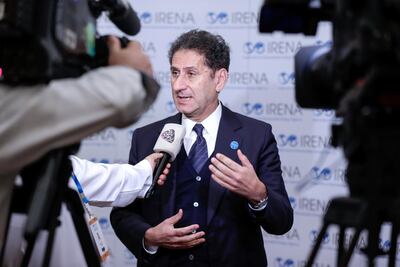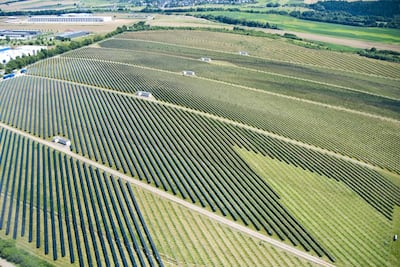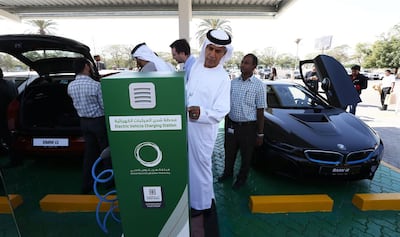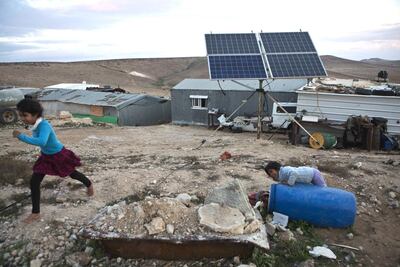This article was produced in partnership with Irena
The International Renewable Energy Agency envisages a very different world.
It is one where a dramatic rise in electric vehicles and renewable technologies will affect our everyday lives. Many of us will require different roles and skills for jobs in the next few years – and how we live our lives will have to change.
The Abu Dhabi-based, intergovernmental organisation today sets out its “1.5˚C scenario”, in line with the goals of the 2015 Paris Agreement. Its scenario gives a glimpse into not only the environmental benefits of tackling planet-warming emissions, but the economic ones as well.
Only a few years ago, the renewables-centred approach espoused by Irena was considered too progressive, idealistic or even unrealistic. Today, our vision has become mainstream
Francesco La Camera,
International Renewable Energy Agency
It is an optimistic vision, but comes with a warning too: We have no time for talk, promises and rhetoric.
In its latest annual report it envisages coal being “phased out”, and investments in oil and gas “limited to facilitating a swift decline and a managed transition”.
Economies already heavily dependent on oil should move into carbon capture and storage, the agency says.
“Carbon capture and storage technologies should facilitate an energy transition in economies heavily dependent on oil and gas and provide a transitional solution where no other options exist,” said the report.
Innovation should target emerging technologies most likely to become competitive in the short-term and most effective in achieving emissions reductions in the long term.
Investments should support the path most likely to drive down energy emissions, said the agency.
And policies should promote “resilience, inclusion, and equity,” ensuring workers and communities adversely affected by the transition to more renewable sources of energy are protected.
Each region and country will progress at its own pace, it said.
Running out of time
A rapid decline in emissions “must begin now” to prevent the temperature from rising more than 1.5°C over pre-industrial levels by 2050.
But current policies will do no more than stabilise global emissions, with a “slight drop” as 2050 approaches, the agency said in a new report.
“We have no time,” said Francesco La Camera, director-general of Irena in a foreword to the report.
“The window is closing and the pathway to a net zero future is narrowing.
“A consensus has formed that an energy transition grounded in renewable sources of energy and efficient technologies is the only way to give us a fighting chance of limiting global warming by 2050 to 1.5°C.
“Only a few years ago, the renewables-centred approach espoused by Irena was considered too progressive, idealistic or even unrealistic.
“Today, our vision has become mainstream.”
He said that the demands were great and full of uncertainty.
“We are entering a new era of change, one in which energy transformation will drive economic transformation,” said Mr La Camera.
“This change is bringing unprecedented new possibilities to revitalise economies and lift people out of poverty. But the task ahead is daunting.”
The world needs to embrace technology, policy and market solutions that will take it forward, he said.
“Economic and human development goals, environmental concerns, and financial avenues must all be reconciled,” he said.
But the changes will have a marked impact on society, affecting everything from the jobs people will do in the future to the way they live their lives.
Here are three of the biggest:
Jobs
The energy sector will employ tens of millions of people, providing around 122 million jobs in 2050.
Jobs in renewable energy will rise from more than 11.5 million today to 43 million in 2050.
Most of them, 38 million, will be created in the next decade, meaning there were will be lots of opportunities for those entering the workforce or looking for jobs.
“We estimate that there will be at least three times more jobs in renewables,” said Elizabeth Press, director for planning and programme support at Irena.
Some of the skills required will be transferable.
But there will also be many jobs in the renewable energy industry that do not yet exist.
“There are additional skills that are required,” said Ms Press.
But many of the top 10 professions in the world did not exist a decade ago, she said.
The report predicts solar technologies will account for the largest share of jobs, followed by bioenergy, wind and hydropower.
“Construction, installation and manufacturing boost renewable jobs during the following decade, with operation and maintenance gaining relative weight as the transition advances,” it says.
Jobs are currently concentrated in areas like the installation and manufacture of renewables technology.
But they are being created in other areas, including construction, in operations and maintenance across a number of countries.
“Construction, installation and manufacturing [will] boost renewable jobs during the following decade, with operations and maintenance gaining relative weight as the transition advances,” it says.
Other jobs may be created in manufacturing and services, says the report.
Fossil fuels will not be switched off overnight, and will still exist to an extent even after renewables come to dominate, said Ms Press.
“We're not just going to switch off fossil fuels tomorrow and say, 'well OK now we're going to be renewable'," she said.
“It's a transition, so this is why we have a plan for 20 years.
“Some of this can be managed by attrition, some of it can be managed by retraining. Obviously, that is something that governments have to plan well in advance.”
The sector would also benefit from attracting new talent.
Women make up 32 per cent of the workforce, which is higher than the 22 per cent of the energy sector overall, but not high enough, according to Irena.
“It is evident women represent a pool of talent yet to be fully utilised,” says the report.
Transport
Electricity will make up the biggest single share of energy generation in the future.
And in no sector will the impact be more apparent than in transport.
Electric vehicle sales currently account for only 4 per cent of all sales, but will rise to 100 per cent by 2050, up from 7 million in 2020 to 1.8 billion in 2050, when electric vehicles will account for 80 per cent of all road transport.
But major improvements in technology are required first.
The report predicts stationary battery storage will more than triple between 2018 to 2050.
“Technology is improving very, very rapidly and all the large car makers have made commitments and deadlines on electromobility. That means there's going to be a lot more innovation around this, because they know they don't make these commitments unless they have a very clear strategy in place to shift,” said Ms Press.
Car makers with commitments to go green include Volvo, which aims to become a fully electric marque by 2030.
Other companies like BMW aim for half of sales to be in electric cars.
But countries will have to upgrade their infrastructure to cope with the growth.
That will lead to some in the Third World leapfrogging advanced economies, said Ms Press.
“In Rwanda, there is a company that is refurbishing normal motorbikes with batteries that are replaceable, and it just got some funding from Silicon Valley because the market is enormous in the global south,” said Ms Press.
“So when you think about it, why would they ever develop an infrastructure when they can have that sort of infrastructure developing right now?
“So, some leapfrogging will definitely happen.
“It is the great equaliser.”
Policies to promote electric vehicles will also continue to increase, further driving the growth in the market.
“All of the top markets for electric vehicles to date, for example China, Norway and the United States, have introduced such policies.”
Norway has a high percentage of electric vehicles as a direct result of policy, said Ms Press.
“They have a lot of inexpensive electricity, and they have put several incentives in place, so everybody in Oslo drives a Tesla,” she said.
“Because you don't have to pay for the parking, you can end up charging for free, because the electricity is so inexpensive.”
Innovation
Technology will become even more integrated into everyday life.
Significant progress has already been made in areas like battery storage, solar power and the Internet of Things.
But that will accelerate, contributing to the rise in the use of renewable technologies, said Irena.
And the growth will partly be driven by people, who will install technologies like solar panels, or even mini wind turbines on their properties.
“What I find super exciting about renewables is it is everybody's business,” said Ms Press.
“Suddenly you will have a lot more control over what you want to have in your life and you can participate. You can actually be part of the system.”
Technologies like blockchain – a tamper-proof ledger of every transaction made in a system – will increasingly be used to share the proceeds of investments into solar energy and other technologies.
Ms Press already takes part, and says these transactions will become more common.
She bought solar panels at a school in South Africa, which uses the power for itself and sells whatever is left over back to the grid.
“Somehow I get paid from the electricity because part of it goes into the school but part of it goes into the market,” said Ms Press. “I don't know the nitty-gritty, but what I found super interesting is I'm sitting in Europe, and I am participating in something that matters to me as a person and I actually don't mind if I earn money or not.
“But it's a lot more fun to look on my app to see what it's like in South Africa right now. How school is going, how it’s feeding into the grid. Seeing all that makes you feel a part of something bigger.”
Dust and sand storms compared
Sand storm
- Particle size: Larger, heavier sand grains
- Visibility: Often dramatic with thick "walls" of sand
- Duration: Short-lived, typically localised
- Travel distance: Limited
- Source: Open desert areas with strong winds
Dust storm
- Particle size: Much finer, lightweight particles
- Visibility: Hazy skies but less intense
- Duration: Can linger for days
- Travel distance: Long-range, up to thousands of kilometres
- Source: Can be carried from distant regions
Tightening the screw on rogue recruiters
The UAE overhauled the procedure to recruit housemaids and domestic workers with a law in 2017 to protect low-income labour from being exploited.
Only recruitment companies authorised by the government are permitted as part of Tadbeer, a network of labour ministry-regulated centres.
A contract must be drawn up for domestic workers, the wages and job offer clearly stating the nature of work.
The contract stating the wages, work entailed and accommodation must be sent to the employee in their home country before they depart for the UAE.
The contract will be signed by the employer and employee when the domestic worker arrives in the UAE.
Only recruitment agencies registered with the ministry can undertake recruitment and employment applications for domestic workers.
Penalties for illegal recruitment in the UAE include fines of up to Dh100,000 and imprisonment
But agents not authorised by the government sidestep the law by illegally getting women into the country on visit visas.
Student Of The Year 2
Director: Punit Malhotra
Stars: Tiger Shroff, Tara Sutaria, Ananya Pandey, Aditya Seal
1.5 stars
The past Palme d'Or winners
2018 Shoplifters, Hirokazu Kore-eda
2017 The Square, Ruben Ostlund
2016 I, Daniel Blake, Ken Loach
2015 Dheepan, Jacques Audiard
2014 Winter Sleep (Kış Uykusu), Nuri Bilge Ceylan
2013 Blue is the Warmest Colour (La Vie d'Adèle: Chapitres 1 et 2), Abdellatif Kechiche, Adele Exarchopoulos and Lea Seydoux
2012 Amour, Michael Haneke
2011 The Tree of Life, Terrence Malick
2010 Uncle Boonmee Who Can Recall His Past Lives (Lung Bunmi Raluek Chat), Apichatpong Weerasethakul
2009 The White Ribbon (Eine deutsche Kindergeschichte), Michael Haneke
2008 The Class (Entre les murs), Laurent Cantet
Strait of Hormuz
Fujairah is a crucial hub for fuel storage and is just outside the Strait of Hormuz, a vital shipping route linking Middle East oil producers to markets in Asia, Europe, North America and beyond.
The strait is 33 km wide at its narrowest point, but the shipping lane is just three km wide in either direction. Almost a fifth of oil consumed across the world passes through the strait.
Iran has repeatedly threatened to close the strait, a move that would risk inviting geopolitical and economic turmoil.
Last month, Iran issued a new warning that it would block the strait, if it was prevented from using the waterway following a US decision to end exemptions from sanctions for major Iranian oil importers.
The%20specs%3A%20Taycan%20Turbo%20GT
%3Cp%3E%3Cstrong%3EEngine%3A%20%3C%2Fstrong%3EDual%20synchronous%20electric%20motors%0D%3Cbr%3E%3Cstrong%3EPower%3A%20%3C%2Fstrong%3E1%2C108hp%0D%3Cbr%3E%3Cstrong%3ETorque%3A%20%3C%2Fstrong%3E1%2C340Nm%0D%3Cbr%3E%3Cstrong%3ETransmission%3A%20%3C%2Fstrong%3ESingle-speed%20automatic%20(front%20axle)%3B%20two-speed%20transmission%20(rear%20axle)%0D%3Cbr%3E%3Cstrong%3ETouring%20range%3A%20%3C%2Fstrong%3E488-560km%0D%3Cbr%3E%3Cstrong%3EPrice%3A%20%3C%2Fstrong%3EFrom%20Dh928%2C400%0D%3Cbr%3E%3Cstrong%3EOn%20sale%3A%20%3C%2Fstrong%3EOrders%20open%3C%2Fp%3E%0A
Skoda Superb Specs
Engine: 2-litre TSI petrol
Power: 190hp
Torque: 320Nm
Price: From Dh147,000
Available: Now
More from Aya Iskandarani
BIRD%20BOX%20BARCELONA
%3Cp%3E%3Cstrong%3EDirectors%3A%3C%2Fstrong%3E%20David%20and%20Alex%20Pastor%3Cbr%3E%3Cstrong%3EStars%3A%20%3C%2Fstrong%3EGeorgina%20Campbell%2C%20Mario%20Casas%2C%20Diego%20Calva%3Cbr%3E%3Cstrong%3ERating%3A%3C%2Fstrong%3E%202%2F5%3C%2Fp%3E%0A
WHAT IS A BLACK HOLE?
1. Black holes are objects whose gravity is so strong not even light can escape their pull
2. They can be created when massive stars collapse under their own weight
3. Large black holes can also be formed when smaller ones collide and merge
4. The biggest black holes lurk at the centre of many galaxies, including our own
5. Astronomers believe that when the universe was very young, black holes affected how galaxies formed
What are NFTs?
Are non-fungible tokens a currency, asset, or a licensing instrument? Arnab Das, global market strategist EMEA at Invesco, says they are mix of all of three.
You can buy, hold and use NFTs just like US dollars and Bitcoins. “They can appreciate in value and even produce cash flows.”
However, while money is fungible, NFTs are not. “One Bitcoin, dollar, euro or dirham is largely indistinguishable from the next. Nothing ties a dollar bill to a particular owner, for example. Nor does it tie you to to any goods, services or assets you bought with that currency. In contrast, NFTs confer specific ownership,” Mr Das says.
This makes NFTs closer to a piece of intellectual property such as a work of art or licence, as you can claim royalties or profit by exchanging it at a higher value later, Mr Das says. “They could provide a sustainable income stream.”
This income will depend on future demand and use, which makes NFTs difficult to value. “However, there is a credible use case for many forms of intellectual property, notably art, songs, videos,” Mr Das says.
Ferrari 12Cilindri specs
Engine: naturally aspirated 6.5-liter V12
Power: 819hp
Torque: 678Nm at 7,250rpm
Price: From Dh1,700,000
Available: Now
Tour de France 2017: Stage 5
Vittel - La Planche de Belles Filles, 160.5km
It is a shorter stage, but one that will lead to a brutal uphill finish. This is the third visit in six editions since it was introduced to the race in 2012. Reigning champion Chris Froome won that race.
COMPANY PROFILE
Name: Kumulus Water
Started: 2021
Founders: Iheb Triki and Mohamed Ali Abid
Based: Tunisia
Sector: Water technology
Number of staff: 22
Investment raised: $4 million
The bio
Who inspires you?
I am in awe of the remarkable women in the Arab region, both big and small, pushing boundaries and becoming role models for generations. Emily Nasrallah was a writer, journalist, teacher and women’s rights activist
How do you relax?
Yoga relaxes me and helps me relieve tension, especially now when we’re practically chained to laptops and desks. I enjoy learning more about music and the history of famous music bands and genres.
What is favourite book?
The Perks of Being a Wallflower - I think I've read it more than 7 times
What is your favourite Arabic film?
Hala2 Lawen (Translation: Where Do We Go Now?) by Nadine Labaki
What is favourite English film?
Mamma Mia
Best piece of advice to someone looking for a career at Google?
If you’re interested in a career at Google, deep dive into the different career paths and pinpoint the space you want to join. When you know your space, you’re likely to identify the skills you need to develop.
New UK refugee system
- A new “core protection” for refugees moving from permanent to a more basic, temporary protection
- Shortened leave to remain - refugees will receive 30 months instead of five years
- A longer path to settlement with no indefinite settled status until a refugee has spent 20 years in Britain
- To encourage refugees to integrate the government will encourage them to out of the core protection route wherever possible.
- Under core protection there will be no automatic right to family reunion
- Refugees will have a reduced right to public funds
UAE currency: the story behind the money in your pockets
The burning issue
The internal combustion engine is facing a watershed moment – major manufacturer Volvo is to stop producing petroleum-powered vehicles by 2021 and countries in Europe, including the UK, have vowed to ban their sale before 2040. The National takes a look at the story of one of the most successful technologies of the last 100 years and how it has impacted life in the UAE.
Read part four: an affection for classic cars lives on
Read part three: the age of the electric vehicle begins
Read part one: how cars came to the UAE
FIGHT CARD
Welterweight Mostafa Radi (PAL) v Tohir Zhuraev (TJK)
Catchweight 75kg Leandro Martins (BRA) v Anas Siraj Mounir (MAR)
Flyweight Corinne Laframboise (CAN) v Manon Fiorot (FRA)
Featherweight Ahmed Al Darmaki (UAE) v Bogdan Kirilenko (UZB)
Lightweight Izzedine Al Derabani (JOR) v Atabek Abdimitalipov (KYG)
Featherweight Yousef Al Housani (UAE) v Mohamed Arsharq Ali (SLA)
Catchweight 69kg Jung Han-gook (KOR) v Elias Boudegzdame (ALG)
Catchweight 71kg Usman Nurmagomedov (RUS) v Jerry Kvarnstrom (FIN)
Featherweight title Lee Do-gyeom (KOR) v Alexandru Chitoran (ROU)
Lightweight title Bruno Machado (BRA) v Mike Santiago (USA)
GOLF’S RAHMBO
- 5 wins in 22 months as pro
- Three wins in past 10 starts
- 45 pro starts worldwide: 5 wins, 17 top 5s
- Ranked 551th in world on debut, now No 4 (was No 2 earlier this year)
- 5th player in last 30 years to win 3 European Tour and 2 PGA Tour titles before age 24 (Woods, Garcia, McIlroy, Spieth)
Groom and Two Brides
Director: Elie Semaan
Starring: Abdullah Boushehri, Laila Abdallah, Lulwa Almulla
Rating: 3/5
Company%20Profile
%3Cp%3E%3Cstrong%3ECompany%20name%3A%3C%2Fstrong%3E%20Hoopla%3Cbr%3E%3Cstrong%3EDate%20started%3A%20%3C%2Fstrong%3EMarch%202023%3Cbr%3E%3Cstrong%3EFounder%3A%3C%2Fstrong%3E%20Jacqueline%20Perrottet%3Cbr%3E%3Cstrong%3EBased%3A%3C%2Fstrong%3E%20Dubai%3Cbr%3E%3Cstrong%3ENumber%20of%20staff%3A%3C%2Fstrong%3E%2010%3Cbr%3E%3Cstrong%3EInvestment%20stage%3A%20%3C%2Fstrong%3EPre-seed%3Cbr%3E%3Cstrong%3EInvestment%20required%3A%3C%2Fstrong%3E%20%24500%2C000%3C%2Fp%3E%0A
What is graphene?
Graphene is extracted from graphite and is made up of pure carbon.
It is 200 times more resistant than steel and five times lighter than aluminum.
It conducts electricity better than any other material at room temperature.
It is thought that graphene could boost the useful life of batteries by 10 per cent.
Graphene can also detect cancer cells in the early stages of the disease.
The material was first discovered when Andre Geim and Konstantin Novoselov were 'playing' with graphite at the University of Manchester in 2004.
UAE squad
Esha Oza (captain), Al Maseera Jahangir, Emily Thomas, Heena Hotchandani, Indhuja Nandakumar, Katie Thompson, Lavanya Keny, Mehak Thakur, Michelle Botha, Rinitha Rajith, Samaira Dharnidharka, Siya Gokhale, Sashikala Silva, Suraksha Kotte, Theertha Satish (wicketkeeper) Udeni Kuruppuarachchige, Vaishnave Mahesh.
UAE tour of Zimbabwe
All matches in Bulawayo
Friday, Sept 26 – First ODI
Sunday, Sept 28 – Second ODI
Tuesday, Sept 30 – Third ODI
Thursday, Oct 2 – Fourth ODI
Sunday, Oct 5 – First T20I
Monday, Oct 6 – Second T20I





